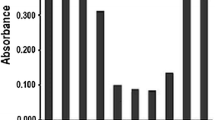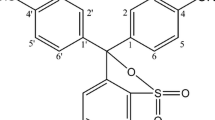Summary
Thorium is concentrated to a small volume by extraction with triphenylarsine oxide in chloroform and back extraction with 4M HCl. The spectrophotometric determination is then carried out in a micro cuvette using the absorption of the arsenazo III complex at 660 nm. By this procedure a sensitivity of 7 ng of Th in 200 ml solution can be achieved. About 60 cations and 20 anions were found not to cause interferences in a wide concentration range. The most disturbing element is U6+ which is coextracted, but leads to an arsenazo complex, which absorbs light at 660 nm about 15 times less than the Th complex. By simple measures, up to 5000 times higher U contents, as to Th, can be tolerated. Also the rare earths do not disturb the Th determination and it was found, that most rare earths chemicals, which were used for the tests, contained Th. The reliability of the method was confirmed by the analysis of standard rocks and by comparing the Th analyses of concrete samples with those obtained by neutron activation analysis.
Zusammenfassung
Thorium wird durch Extraktion mit Triphenylarsinoxid in CHCl3 und Rückextraktion mit 4 M HCl auf ein kleines Volumen konzentriert. Die Endbestimmung erfolgt spektralphotometrisch als Arsenazo-III-Komplex bei 660 nm in Mikroküvetten. Auf diese Weise konnte vor allem die Bestimmung von Spurenmengen Th wesentlich verbessert werden. 7 ng Th sind in bis zu 200 ml Ausgangslösung noch bestimmbar. Untersuchungen mit über 60 Kationen und etwa 20 Anionen zeigten, daß diese in weiten Grenzen nicht stören. U6+ wird zwar auch mitextrahiert, gibt aber in der salzsauren Rückextraktionslösung mit Arsenazo III einen etwa 15mal weniger lichtabsorbierenden Farbkomplex. Da aber Uran von den getesteten Kationen trotzdem am meisten stört und in Analysenproben das Th oft begleitet, werden weitere einfache Maßnahmen gezeigt, die einen bis zu ∼5000fachen Überschuß an Uran erlauben. Es wurde gefunden, daß auch die Seltenen Erden nicht stören und die zum Test verwendeten Seltenen Erd-Chemikalien Th enthalten. Bestimmungen in Standardgesteinen und Zementproben bestätigen die Anwendbarkeit der Methode.
Similar content being viewed by others
Literatur
Abbey, S.: Anal. Chim. Acta 30, 176 (1964)
Bajo, C.: Nuclear Tracks 3, 101 (1979)
Bazzano, E., Ghersini, G.: Anal. Chim. Acta 38, 457 (1967)
Cerrai, E., Ghersini, G.: Anal. Chim. Acta 37, 295 (1967)
Flanagan, F. J.: Geochim. Cosmochim. Acta 37, 1189 (1973)
Keil, R.: Fresenius Z. Anal. Chem. 297, 384 (1979)
Keil, R.: Fresenius Z. Anal. Chem. 286, 54 (1977)
Koch, O. G., Koch-Dedic, G. A.: Handbuch der Spurenanalyse, Bd. 2, S. 1181. Berlin, Heidelberg, New York: Springer 1974
Pietsch, R., Nagl, G.: Mikrochim. Acta 1965, 1086
Savvin, S. B.: Talanta 8, 673 (1961)
Savvin, S. B.: Talanta 11, 1 (1964)
Savvin, S. B.: Talanta 11, 7 (1964)
Author information
Authors and Affiliations
Additional information
Für die Überprüfung des Manuskriptes möchte ich Herrn Dr. P. Baertschi herzlich danken.
Rights and permissions
About this article
Cite this article
Keil, R. Selektive spektralphotometrische Spurenbestimmung von Thorium mit Arsenazo III nach Extraktionstrennung. Z. Anal. Chem. 305, 374–378 (1981). https://doi.org/10.1007/BF00483201
Received:
Issue Date:
DOI: https://doi.org/10.1007/BF00483201




